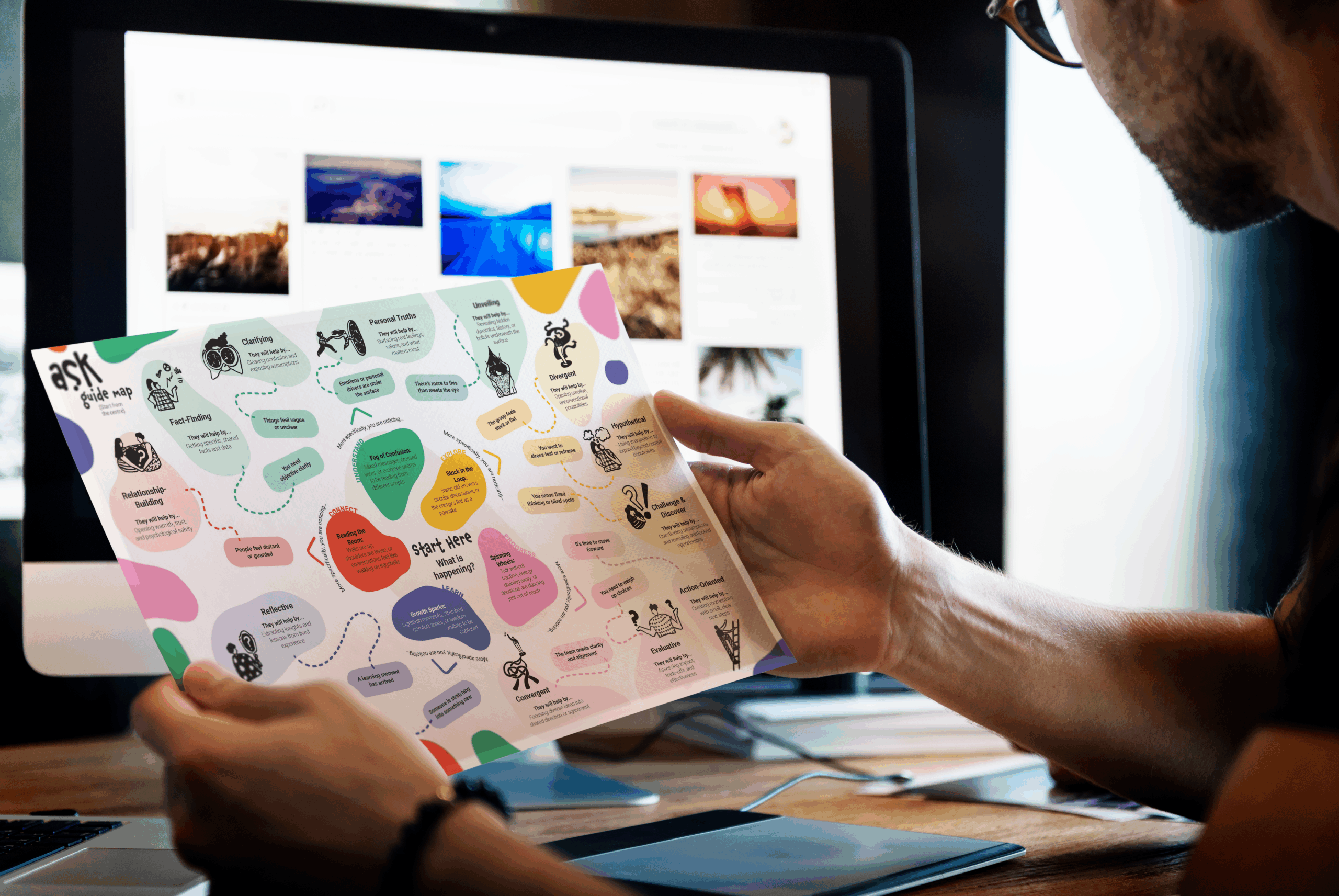
In different areas of life, we often use different language. How we frame up our conversations varies from home to the workplace, with family and with friends. When it comes to leadership, the central building block of our conversations, in our view, must be questions.
Asking questions creates an engaging context, inspires active participation, and fosters deeper and more creative thinking; so it makes sense that the ability to ask great questions is one of the standout traits of great leaders. Simply by making the switch from telling to asking will make a positive difference, but if you really want to have maximum impact, learning how to craft the right question for the right moment is key.
People-centred vs Work-centred Questions
In the work context, we can broadly categorise questions into those related to people or relationships, and those related to more concrete technical or performance aspects of work. We break down these two categories here:
People-centred questions
Focus on the individual or team, particularly their feelings, motivations, relationships, wellbeing or perspectives. The main purpose of asking these types of questions is to build rapport, nurture psychological safety, strengthen relationships and tap into the collective wisdom of the diversity of the team.
TIP: Timing and context are critical when asking people-related questions! These are foundational questions that help create safety and trust, so should be asked with sincere empathy and active listening present. Based on science, when people’s need for safety and trust is met, their contribution to task-focused questions will be of greater value.
Work-centred questions
Focus on tasks, projects, data, processes, goals and outcomes. The main purpose of these questions is to gather information, define objectives, solve problems, make decisions, plan actions and evaluate results.
TIP: These questions are best asked with clarity and focus, however should be used in conjunction with people-centred questions to ensure the human element of work is being considered.
Understanding and respecting the differences between these two types of questions is crucial to establish a consistently high performing team. In practice, the drive for results and quick action can easily influence us to gloss over people-centred questions and dive into the work or task related aspects. Although you may get some of the answers you need in that moment, you may not get honesty, buy in or even land on the optimal outcome.
Types of Questions
Through using questions with leaders, we have discovered that they are powerful tools to achieve a range of goals, not just for open exploration. They can also provide powerful scaffolding to refine ideas, progress forward, drive action and learn from the past. We’ve curated a set of five categories of questions to help you effortlessly navigate and select the right one for each moment.
Questions to Connect:
These are questions that help to build rapport, establish safety and understand people better.
Example: “What’s been on your mind?”, “What are you hoping to get out of this meeting?”, “When was the last time you felt engaged in a team, and what contributed to that feeling?”
Questions to Understand:
These questions will facilitate seeing the facts of the matter, understanding the situation through gathering data and exploration of different perspectives.
Example: “Can you tell me more about that?”, “What data do we have on this?”, “What assumptions are we making?”
Questions to Explore:
Asking these questions will stimulate creative thinking, generate ideas, open up new possibilities and encourage expression and energy.
Example: ”What are all the different ways we could approach this?”, “If resources weren’t an issue, what would we do?”, “What could we learn from how another industry handles this?.”
Questions to Progress:
These are used to move things forward, make decisions, define next steps and drive action.
Example: “Based on what we’ve discussed, what’s the next logical step?”, “Who is responsible for what by when?”, “How will we know if we’re on track?”
Questions to Learn:
We ask these questions to reflect, foster continuous improvement and gain insights from the past.
Example: “What did we learn from this project/situation?”, “What went well, and what could be improved?”, “How can we apply this learning moving forward?”
Choosing the Right Question
By using these categories as a guide, you are in an ideal position to find the right question to achieve your desired outcome. Some leaders will have a natural ability to sense the appropriate question for the scenario, however many benefit from some structure to guide them towards the most effective strategy – particularly at first.
We developed the ASK Toolkit as a simple and pragmatic guide to provide scaffolding for leaders to get to the right question sooner. The toolkit includes a full graphic navigation map to help you choose the right question for the right time, and we have summarised the main steps here.
The first step is to observe what is currently happening in the environment and name what you’re noticing. You may need to set aside some time for yourself to observe and really take in the signals the environment and team are giving you. This is best done in a grounded, regulated state with an open, receptive mindset. Examples of things you may notice are: how people’s walls are up, that team dynamics are tense, or there is lots of talk without action and a sense of drained energy.
After tapping into the current state of the team, look a bit deeper and see if you are able to notice anything more specific. For example, you may have noticed the team being a bit stuck in the same old loop. On further observation, you can see that the group seems flat in energy, which could be contributing to the problem. In this instance, asking divergent questions will stimulate neural activity to activate energy and open creative and novel thinking which can lead to better results and also an energised experience for the team.
TIP: The more details you’re able to identify, the more targeted you can be in your questioning strategy!
Once you have named the current circumstances with as much clarity and specificity as you can, you are ready to consider what type of question will support the direction or outcome you’d like to achieve. For example, if you have noticed spinning wheels, difficulty making decision or taking tangible steps forward, you may opt for a questioning strategy that focuses on Progress Questions, which can foster diverse ideas into a shared direction, and create momentum through small clear next steps.
The final step in the process is crafting the actual questions. Now that you have a sense of the energy of the team and environment and the goals you’re aiming to achieve, you can either create your own questions or you can draw from the ASK Toolkit where we have curated more than 200 powerful questions, categorised by type for easy application.

What happens when we miss the mark?
Of course, there is no absolute right or wrong way to go about asking questions. However, there are some undesirable outcomes that can occur when we miss the mark. Asking the wrong type of question for the situation can bring up feelings of frustration and disengagement in the team, particularly where they feel like their actual needs are being ignored or dismissed. It’s no surprise that asking the wrong types of questions repeatedly will eventually erode trust and make it harder for you to inspire high performance in the team.
Failing to ask the right questions may also mean you miss the opportunity to solve your challenge or unlock the full potential of the moment. You may get superficial or inaccurate answers which lead down an unhelpful path. Moving through the various categories when the time calls for it is a purposeful way to minimise these risks and give your team the best chance at reaching their potential.
Putting it into Practice
Mastering the art of asking questions takes courage and practice. It demands self-awareness, humility and sincere curiosity about the people you are working with. Start building your practice today!
To help you develop this essential leadership skill, we have compiled the ASK Toolkit. The practical toolkit has been developed to be a handy support which includes a comprehensive guide and navigation map to choose the right types of questions as well as a library of powerful, purpose-built questions to help you lead with curiosity, clarity and care.
To read the other articles in this series, check out the links below.






